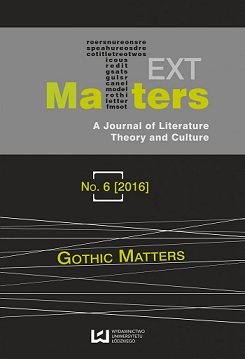“It’s not just a dream. There is a storm coming!”: Financial Crisis, Masculine Anxieties and Vulnerable Homes in American Film
DOI:
https://doi.org/10.1515/texmat-2016-0010Abstract
Despite the Gothic’s much-discussed resurgence in mainstream American culture, the role the late 2000s financial crisis played in sustaining this renaissance has garnered insufficient critical attention. This article finds the Gothic tradition deployed in contemporary American narrative film to explore the impact of economic crisis and threat, and especially masculine anxieties about a perceived incapacity of men and fathers to protect vulnerable families and homes. Variously invoking the American and Southern Gothics, Take Shelter (2011) and Winter’s Bone (2010) represent how the domestic-everyday was made unfamiliar, unsettling and threatening in the face of metaphorical and real (socio-)economic crisis and disorder. The films’ explicit engagement with contemporary American economic malaise and instability thus illustrates the Gothic’s continued capacity to lay bare historical and cultural moments of national crisis. Illuminating culturally persistent anxieties about the American male condition, Take Shelter and Winter’s Bone materially evoke the Gothic tradition’s ability to scrutinize otherwise unspeakable national anxieties about male capacity to protect home and family, including through a focus on economic-cultural “white Otherness.” The article further asserts the significance of prominent female assumption of the protective role, yet finds that, rather than individuating the experience of financial crisis on failed men, both films deftly declare its systemic, whole-of-society basis. In so doing, the Gothic sensibility of pervasive anxiety and dread in Take Shelter and Winter’s Bone disrupts dominant national discursive tendencies to revivify American institutions of traditional masculinity, family and home in the wakes of 9/11 and the recession.
Downloads
References
Barker, Deborah, and Kathryn B. McKee. “Introduction: The Southern Imaginary.” American Cinema and the Southern Imaginary. Ed. Deborah Barker and Kathryn B. McKee. Athens: U of Georgia P, 2011. 1–23. Print.
Google Scholar
Bell, James. “Meth and the Maiden.” Sight and Sound 20.10 (2010): 28–29. Print.
Google Scholar
Berra, John. “American Independent Gothic: Winter’s Bone.” The Gothic Imagination. 2011. Web. 18 Dec. 2014.
Google Scholar
Blake, Linnie. “Vampires, Mad Scientists and the Unquiet Dead: Gothic Ubiquity in Post-9/11 US Television.” The Gothic in Contemporary Literature and Popular Culture: Pop Goth. Ed. Justin Edwards and Agnieszka Soltysik Monnet. London: Routledge, 2012. 37–56. Print.
Google Scholar
Boyle, Kirk. “The Imagination of Economic Disaster: Eco-Catastrophe Films of the Great Recession.” The Great Recession in Fiction, Film, and Television: 21st Century Bust Culture. Ed. Kirk Boyle and Daniel Mrozowski. Lanham: Lexington, 2013. 3–28. Print.
Google Scholar
Donnar, Glen. “‘Ah, You Lose You in There’: Gothic Masculinities, Specters of Vietnam and Becoming Monstrous in Southern Comfort.” War Gothic in Literature and Culture. Ed. Agnieszka Soltysik Monnet and Steffen Hantke. New York: Routledge, 2015. 136–53. Print.
Google Scholar
Goddu, Teresa A. “American Gothic.” The Routledge Companion to Gothic. Ed. Catherine Spooner and Emma McEvoy. Hoboken: Taylor, 2007. 63–71. Print.
Google Scholar
Inside Job. Dir. Charles Ferguson. Sony Pictures Home Entertainment, 2010. DVD.
Google Scholar
Leeuwen, Evert Jan Van. “Gothic Eurowesterns: A Grotesque Perspective on a Hollywood Myth.” Bright Lights Film Journal 60 (2008): n. pag. Web. 18 Feb. 2014.
Google Scholar
Margin Call. Dir. J. C. Chandor. Becker Film Group, 2011. DVD.
Google Scholar
Negra, Diana, and Yvonne Tasker. “Introduction. Gender and Recessionary Culture.” Gendering the Recession: Media and Culture in an Age of Austerity. Ed. Diana Negra and Yvonne Tasker. Durham: Duke UP, 2014. 1–30. Print.
Google Scholar
Pinkerton, Nick. “Southern Gothic.” Sight & Sound 25.5 (2015): 44–50. Print.
Google Scholar
Pinkerton, Nick. “Trouble in Mind.” Sight & Sound 21.12 (2011): 46–48. Print.
Google Scholar
Punter, David. “The Uncanny.” The Routledge Companion to Gothic. Ed. Catherine Spooner and Emma McEvoy. Hoboken: Taylor, 2007. 129–36. Print.
Google Scholar
Punter, David, and Glennis Byron. The Gothic. Malden: Wiley, 2004. Print.
Google Scholar
Savoy, Eric. “The Face of the Tenant: A Theory of the American Gothic.” American Gothic: New Interventions in a National Narrative. Ed. Robert K. Martin and Eric Savoy. Iowa City: U of Iowa P, 2009. 3–19. Print.
Google Scholar
Shotgun Stories. Dir. Jeff Nichols. Madman Entertainment, 2009. DVD.
Google Scholar
Soltysik Monnet, Agnieszka. The Poetics and Politics of the American Gothic: Gender and Slavery in Nineteenth-Century American Literature. Farnham: Ashgate, 2010. Print.
Google Scholar
Sorrento, Matthew. “Searching the Wasteland: Debra Granik’s Winter’s Bone.” The New American Crime Film. Jefferson: McFarland, 2012. Print.
Google Scholar
Take Shelter. Dir. Jeff Nichols. Sony Pictures Home Entertainment, 2012. DVD.
Google Scholar
Warwick, Alex. “Feeling Gothicky?” Gothic Studies 9.1 (2007): 5–15. Print.
Google Scholar
Winter’s Bone. Dir. Debra Granik. Lionsgate, 2010. DVD.
Google Scholar
Downloads
Published
How to Cite
Issue
Section
License

This work is licensed under a Creative Commons Attribution-NonCommercial-NoDerivatives 4.0 International License.













